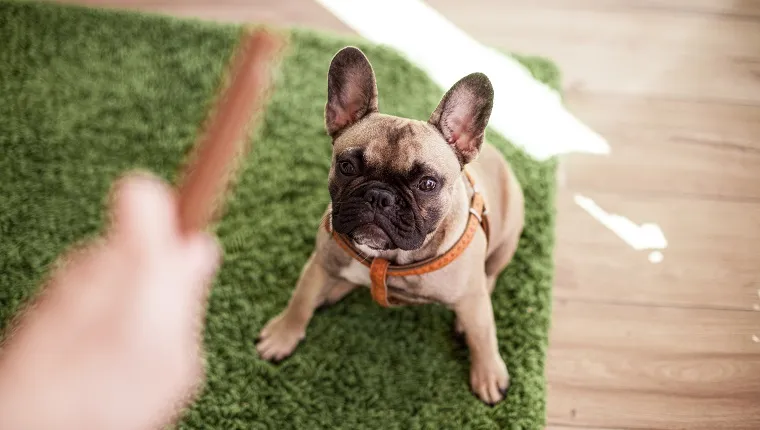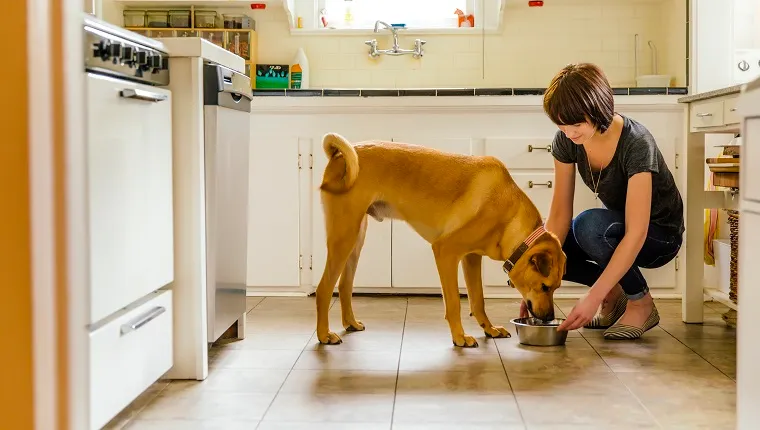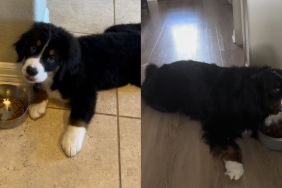Who owns the dog food in your house once it hits the bowl? Does Rover run you out of the kitchen when he is eating dinner? What happens if you need to take away a tasty bone or chew?
If food, bones, or chews turn your sweetie into a growling, snarling monster, then your dog has an issue with resource guarding, or CPA — canine possession aggression. Food aggression is the most common form of CPA.
Here’s what you should know about food aggression and guarding in dogs and what you can do about it.
Does Your Dog Eat Alone Or In Good Company?
We tend to teach our children to “leave the dog alone while they eat.” This is for good reason, as most dogs view small children no differently than they view other dogs.
However, if the adults in the family must also tip-toe around the dog when they’re eating, the dog may perceive themselves as the true “owner” of the food. In the wild, dogs claim valued resources and will eat while guarding food from other dogs or animals who might take their food.
Our family dogs should allow us to reach down and pick up their bowl, even when they are in the middle of eating. Our pups must learn to tolerate the presence of people being close to them while eating, and also to tolerate having a bone or toy taken away.
Early Training: Practice The ‘Give Me That’ Exercise

Ideally, we start convincing puppies that we are the boss, and therefore the true owner of their food, at an early age.
Many training books advise pet parents to “trade” if a pup grabs any forbidden object by exchanging a treat for the object. The problem is that the forbidden object is often more valuable to the dog than the treat.
One very helpful training exercise consists of teaching pups to allow us to open their mouths, so that we can either remove or add something (if you need to give the dog a pill, for example). We call this the “Give Me That” exercise.
Start by putting a dab of plain cream cheese or peanut butter on the end of your index finger.
Go to your pup and say, “give me that,” in the same tone that you’d use if they had something you didn’t wish for them to have, while at the same time opening their mouth, then quickly placing the cream cheese on their tongue.
Walk calmly away afterwards, just as you would if you had taken something from them. If the pup gets used to hearing “give me that” with the positive of adding a wonderful taste to their mouth, then it will be less difficult when you need to open their mouth to take something from them.
If your pup doesn’t resent having their mouth opened, it will also be easier to administer medication, brush the dog’s teeth, or have the veterinarian examine their mouth.
After a week or so of opening the mouth and giving them cream cheese or peanut butter, progress to opening their mouth and rubbing a finger over their teeth. Eventually, move on to using flavored dog toothpaste and a finger brush to clean their teeth daily.
Control The Bowl & Teach Your Pup Patience
Teach your dog that you own the rights to the food, and that they must exhibit impulse control at the dinner table, by fixing the dog’s food and leaving it on the kitchen counter.
Then sit down at the table yourself with any type of food — you can even eat a couple of crackers — and eat first, before giving your dog their. The dog should sit and wait patiently until you are finished, and then you can put their bowl down.
If your dog is too impulsive to wait, then bring their crate into the kitchen and pull it up beside you, and crate them while you are eating. Before giving them dinner, let them out of the crate, and have them sit before you put down the bowl.
Have the full ration of dog food in another bowl, and put only a small handful into their dish. As they’re eating, reach down and add another handful, so that they get used to having your hands in or near their bowl.
Occasionally reach down and pick up the bowl while they’re eating, wait a few seconds, ask them to sit, then put it back down.
Always give your dog an adequate amount of food at each meal, so that they don’t feel deprived or hungry. A hungry dog will nearly always have impulse control issues around food.
If your dog is overweight, your veterinarian can recommend a food for weight control or you can add roughage like canned green beans or fresh grated carrots. This helps them feel fuller without having consumed extra calories.
Working With The Dog Who Already Has A Problem

Occasionally we adopt a dog who has already had many years of controlling their food bowl and bones. Sometimes dogs who have been rescued from a puppy mill or neglectful environment actually did have to fight for their food.
In either case, doing the puppy exercises listed above may not be a safe option.
Realize that it is not all about the food; rather, it’s about the relationship. Your dog must learn to trust that you are a competent, capable leader who is in charge of everything, including the territory and the valued resources. They must trust that you have their best interests at heart.
Work with a qualified behaviorist or an experienced trainer who can help you convey leadership to your dog in a kind but firm manner. Demonstrating leadership will help your dog feel safer and more secure.
Start by taking up all bones and toys and putting them in a basket or box where your dog cannot reach them. They can only chew on one thing at a time, so no more than one item should be on the floor or in their crate at any one time.
If you come into a room and see the toy or bone just lying there, the dog ignoring it, simply pick it up and put it back in the basket. If your dog needs something to play with, then call them to you, have them sit, then reach in and get something and give it to them.
This conveys to the dog that the toys and bones are yours, and you are allowing them to play with the items, instead of vice-versa.
Apply Your Training To Meal Time
In relationship to their food bowl, start simply. Have your dog sit before you put the food down. Once they can do this, progress to standing near them as they eat, ignoring any displays of growling or guarding.
After a few days, if you have not tried to take it away, your dog should accept your closeness to the food. Once they do this, then start using your foot — with shoes on, please — to push the bowl a bit while they’re eating.
Start by doing it just once during their dinner, but progress to the point where you can actually push the bowl totally away from them, and stand between the dog and the bowl.
If you think your dog is likely to have a temper tantrum, then have them attached to their leash, so you can pick up the leash and pull them away if needed.
Dogs do understand that leaders can make them move, even away from valued items, so the use of a leash, or your body blocking them, or your foot pushing are all leadership exercises. For best results, do all of these things without talking at all.
Be Patient & Persistent, Yet Calm & Collected

When starting leadership exercises of any kind, including those that revolve around the food bowl, do so with confidence, yet quietly and calmly. If we yell loudly, or even chatter incessantly, we are not being responsible pack leaders.
Remember, you are the one who provides the food and the toys, and you are the one responsible for making sure your dog is not a danger to anyone. So, you have not only the right, but the responsibility, to step into the role of pack leader.
Be persistent, and don’t give up. Almost every dog can accept that adult human beings have control over the food, bones, and toys.
Keep in mind, however, that dogs view smaller children more like other dogs, pack members equal to themselves, so do not do any of these exercises with your children present, and never allow your children to do anything that might put them at risk.
If implementing these suggestions does not cause a significant improvement in your dog’s food aggression behavior within three weeks, then consider contacting an experienced canine behavior specialist. They can help by evaluating your dog and making sure that there are not other issues which need to be addressed.
Have you ever trained a dog with food aggression issues? Do you have any advice for other pet parents? Let us know in the comments below!









